Billed as the smallest full function dive computer, the SubGravity H3 powered by SeaBear is a powerhouse of a dive computer in a watch-sized case. Designed for the diver looking for a computer that can do it all. From NDL recreational diving to tech diving with trimix to closed circuit rebreather, the SubGravity H3 is ready for most anything you can want to dive and ready to go without paying for any upgrades. That’s right, no paying extra to unlock the trimix or CCR functions, the SubGravity H3 comes fully loaded and fully capable from the get go. One more thing, the H3 is also depth rated to 426.5’ (130m) bringing some great features to those that like to dive deep.
Words & Photos by Tim Lund, California Diver Magazine
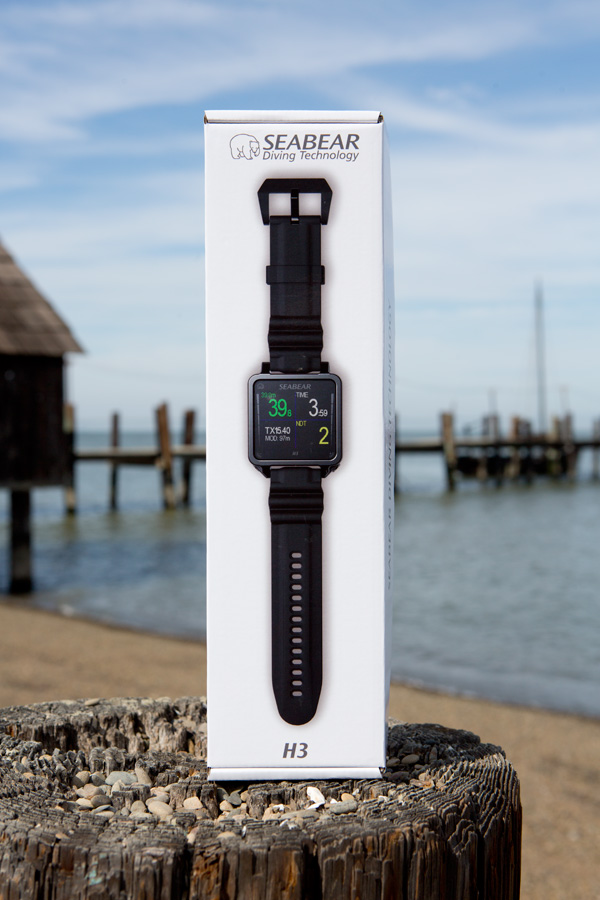
Pic 1: The H3 as it arrived from SubGravity. You don’t need a big package when it contains a small computer.
A powerful computer in a compact package
The first thing that catches your attention is really how small the H3 is. Measuring in a bit less than 2” square and only ½” thick, it is definitely a small dive computer. When you look at the specs – from air to nitrox, trimix to closed circuit rebreather, with 8 gas capability and a tilt-compensated digital compass all being ran by a 32 bit micro controller – you realize that this is in fact a very big dive computer.
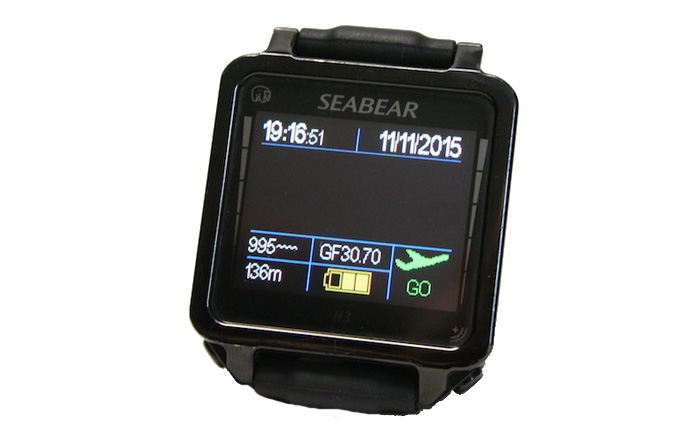
The H3s super crisp, full-color display really pops. The screen brightness can be adjusted from 1-10; the default is setting #7. The main screen is shown here.
A beautiful display
The second thing that catches your attention is the ultra crisp full color OLED screen, so crystal clear that you can read it as well at 150’ as you can at 20’. Dive much in low viz waters, deep dark caves or just love to do night dives? The OLED display is easy to read, even in very demanding dive conditions.
What is OLED? OLED stands for organic light emitting diode, it is basically a LED where the light is produced or “emitted” from thin layers of light emitting films of organic molecules. OLEDs generate their own light, so no backlight is needed, giving you good battery life and a very bright display compared to standard LED displays. An added benefit of producing their own light, OLEDs also have large fields of view, so you don’t have to view the display straight on at a 90* angle.
Protecting that impressive OLED screen is an equally impressive scratch resistant sapphire glass window. Being the third hardest material after diamonds and moissanite, sapphire makes the H3 window very tough and very scratch resistant and after bouncing off barnacle-covered rocks more than once during entries and exits on big surges, I would attest that this computer is quite tough.
What is sapphire glass? Sapphire glass is a synthetic crystalline sapphire material that has a very wide transparency range and is known for being extremely scratch resistant. From shatter resistant windows in armored vehicles to lasers to grocery store barcode scanners, sapphire glass is used where extreme hardness, toughness and transparency is needed.
Built for durability, functionality
Any dive computer boasting a high quality screen and uber-strong glass needs an equally awesome case to hold it all together and the H3 does not disappoint. Constructed from marine grade 316L stainless steel, bringing high strength and high corrosion resistance to the table, the H3 is one well-built unit.
So it is built super tough with really cool materials, but what about functions and controlling those functions you ask? With only two buttons, one on each lower corner, the H3 is simple to navigate. Using a short push to navigate and a long push to select, you can roll through the menus with speed.
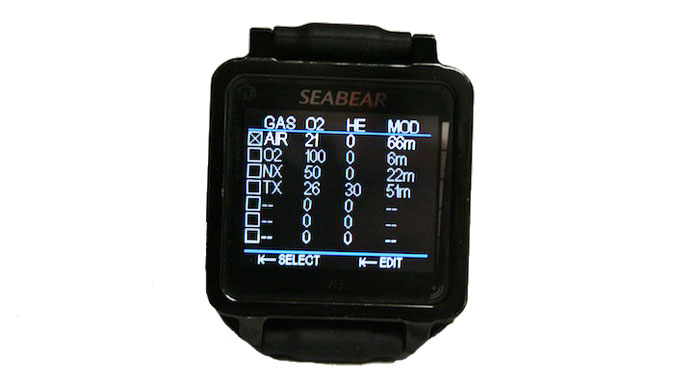
Navigation and control via long or short pushes of the button. Note the arrow legends in the bottom corner; short arrow signifies a short push, long arrow for a long push.
For dive information the H3 gives the user two different screens to select from; the primary screen shows depth, dive time, NDL (no decompression limits), gas selection and has a tissue loading graph. The second screen is a four block split showing depth, dive time, NDL and gas selection in larger digits.
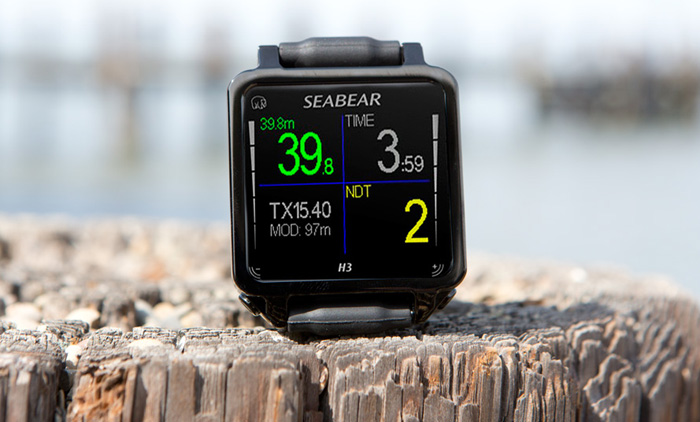
The H3s super crisp, full-color display really pops. The screen brightness can be adjusted from 1-10; the default is setting #7.
8 programmable gas capability
Whether you are planning an extended time dive to 99’ (30m) with a nitrox deco or are planning to hit 400’ (122m) with multiple gas changes down and back, the H3 has got you covered. For multiple gas diving, the H3 offers single button gas switch; as you approach your programmed switch depth, the gas symbol start to blink, first switch your gas and then simply give the right button a long push to confirm. You can also switch gases through the gas submenu.

The gas submenu can list up to 8 different gas mixtures, is simple to get to and simple to edit with the H3 short or long push of the buttons.
For calculating inert gas tissue loading and release, the H3 uses the well-known Bühlmann ZH-L16 decompression algorithm. The deco model has 16 hypothetical compartments for tracking nitrogen and an additional 16 hypothetical compartments for tracking helium. For conservatism settings, the H3 has four predefined gradient factors to choose from. The default setting is a nice conservative 35/85 and is what we used for all our testing. There is one setting that is more conservative and the remaining two go less conservative. It’s nice to have choices, but unless you know what you are doing, we’d suggest staying with the default setting.
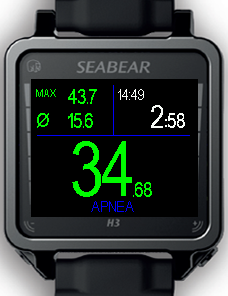
The apnea screen is similar to the screen in the bottom timer mode. In this example it shows 34.6m current depth, 43.7m maximum depth, 15.6m average depth and 2.58 min dive time.
Apnea mode for free divers
For free divers, the SubGravity H3 can be switched into Apnea mode. The apnea screen is similar to the screen in the bottom timer mode and shows current depth, maximum depth, and dive time. In apnea mode, no decompression calculations are carried out.
Integrated compass
One feature we were really impressed with was the 3 axis tilt compass. Never having played with a digital compass before, it was quick to learn how to set headings and the 3 axis tilt makes reading the computer real simple, no more having to hold the compass perfectly level to get a reading, just quick glances at your wrist. The H3 compass also features up to three programmable heading settings; once a heading is programmed in, you let the compass lead the way, if you deviate from the heading a blue arrow pops up pointing left or right, whichever direction is needed to get you back on course.
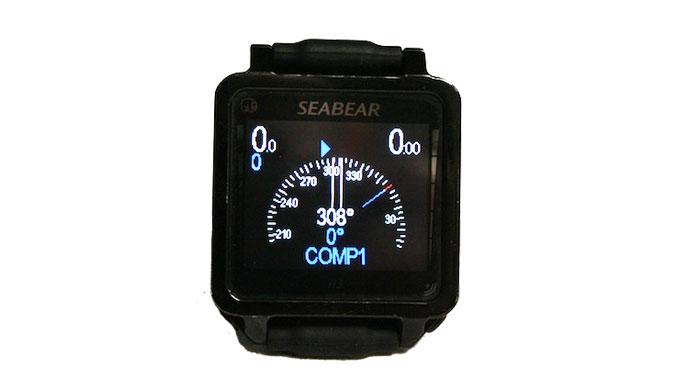
The programmable headings on the compass make following your course quite easy, if you get off course, blue arrows point left or right to help direct you back on course.
Integrated altimeter
The integrated pressure sensor on the H3 not only gives you depth during your dive, it also acts as an altimeter that will measure your altitude from 0-30,000’ (10,000m). So if you like to go hiking, climbing or any multitude of other outdoor activities, the compass and altimeter functions coupled with its tough, waterproof case makes the H3 more than just a dive computer.
Power and connectivity
For charging and data transfer duties the H3 has a USB built into the side of the case allowing recharging of the built-in battery and to download dive log files. For downloading files the H3 also offers Near Field Communication (NFC) to NFC enabled smart phones and for even speedier sharing with social media, there is an app for the Android smart phones that allow sharing your dive data on Facebook.
The built in Li-ion 4.2V, 900mAh battery can power the H3 for up to 15 hours in dive mode and SubGravity claims it will keep the H3 running for up to a year in stand-by mode. With my longest dive being just over an hour and a half and no more than three dives in a day and the computer never being out of the water for more than a week, I doubt we will be finding the limits of the battery anytime soon.
Li-ion stands for Lithium-Ion and is used in many electronics where a small, lightweight and rechargeable battery is desired. Li-ion batteries have high energy density, meaning they can store a lot of energy in a small package. They work by moving lithium ions through a thin membrane differing from standard lithium batteries that use lithium metal and are not rechargeable.
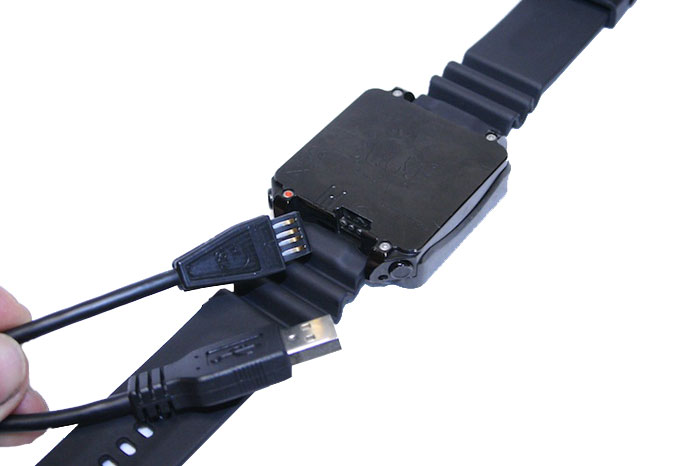
The charging/data transfer port is found on the side under the lower wrist strap with charging and data transfer carried out by a USB capable cord included with the SubGravity H3.
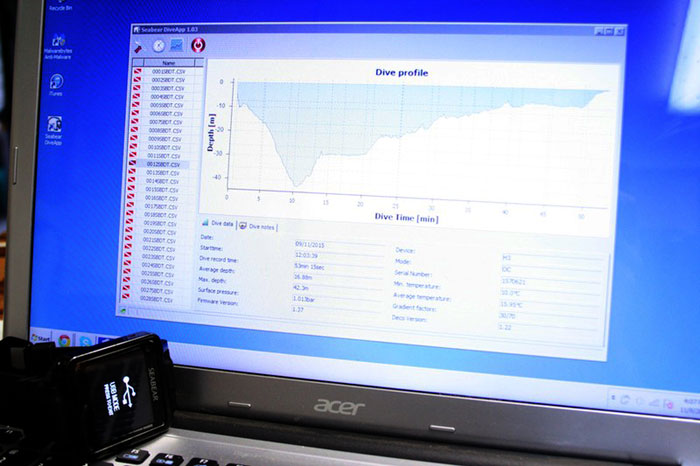
Data files can be downloaded to any PC based computer. Unfortunately due to development requirements/standards the H3 is not Apple compatible at this time.
Its not just a dive computer
The H3 is small enough to be worn like a watch and for those watch geeks/enthusiasts, it is definitely an attention getter. After wearing it to a couple different events, I was really surprised how many people came up to me to ask about the H3, wanting to know all the neat details and all were equally surprised to find out it was a full function dive computer. The day-to-day watch function is not all that techie, but a long button push of the left button and the H3 quickly powers up to full impress mode.
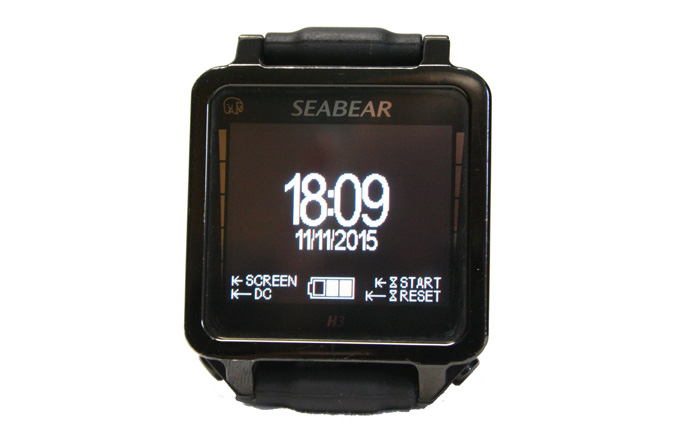
The H3s outdoor watch mode is a simple display with time, date and battery level. The stopwatch is activated via a short push on the right hand button.

The H3 can be worn as a wristwatch and it definitely grabs the attention of the watch techies out there. Enjoying a cold brew with a hairy friend at the Big Foot Brew Fest, in Seabrook, WA on the way home after a morning of diving.
For attachment points the SubGravity H3 uses a high-zoot, cold-resistant stretch-tech wristband and comes with a wristband extender to allow it to reach around thick dive suits. Even with a couple layers of thermal protection under a crushed neoprene drysuit, the H3 wristband with extender band had more than enough adjustment for a nice fit.
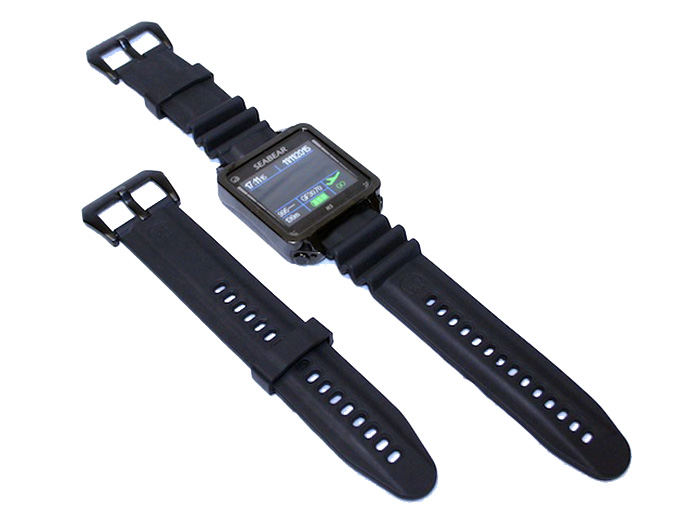
SubGravity includes a wristband extender for those wearing bigger, thicker dive suits and thermal protection. For those warm water divers, you can leave the extender in your dive bag as the standard wristband works perfect for sans dive suit or a thin dive suit/abrasion protection suit style diving.
So how did we like the Subgravity H3?
After spending a few months and over 30 dives with the Sub Gravity H3, I am really getting the feel for this big dive computer in a little package. Is it the do all, be all, dive computer for you? As with anything, your style of diving and training should dictate your equipment. For me, I like that this computer can go from beginner to very advanced as my dive experience and training progresses and that was exactly what I was looking for: something small, but state of the art; something that could stay with me through the next few years as I extend my dive training from recreational into light technical diving and then onto my ultimate goal of closed circuit rebreather (CCR) for longer deeper dives.
SubGravity H3 Specifications
• Air / NITROX / TRIMIX / Constant PO2 (CCR Mode) ZH-L16 Algorithm
• 8 programmable gases
• Outdoor watch mode
• Sapphire glass window
• 426.5’ (130m) depth rating
• Tilt compensated compass with 3 programmable headings
• Altimeter
• Android App available
• FACEBOOK ready (share your dives on social networks)
• NFC (near field communication) integration into mobile environments
• Wireless data download
• 32 Megabit Flash memory
• Rechargeable Li Ion battery, 4.2V, 400mAh,
• Battery lasts up to 15 hours in dive mode, 1 year in watch/standby mode
• Fully charges in 2 hours
Price as tested: $975.00 USD
Source: SubGravity (www.sub-gravity.com) – 801-256-6608
Words & Photos by Tim Lund, California Diver
Pictures taken with SeaLife HD+ camera, Canon Rebel and iPhone 6.
.
